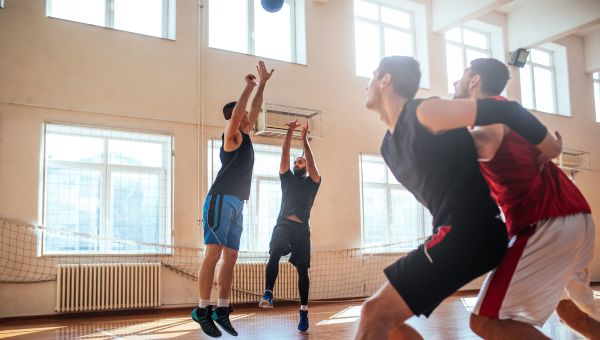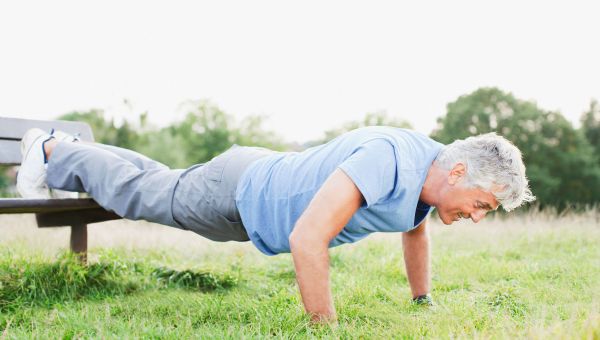6 workouts for men who hate exercise
If you don’t like going to the gym, these easy lifestyle tweaks might just motivate you to move.

Finding the time to exercise can be challenging—even for those who are motivated to work out. Family commitments, work deadlines and poor sleep can all conspire to thwart your fitness goals. And when you’re tired in the morning and just want to put your feet up at the end of a long day, making time for a workout somewhere in between may seem like a long shot, particularly when you’re allergic to signing up for a gym—let alone setting foot inside one.
If this sounds familiar, you’re not alone. Only 27 percent of American men, on average, are getting the recommended amount of exercise, the U.S. Department of Health and Human Services reports. But being inactive could increase your risk for obesity and other chronic health issues, including cardiovascular disease and depression. On the flipside, regular exercise can help lower the risk of heart disease, stroke and hypertension, and can also ease stress and help you sleep better, along with a slew of other health benefits.
Sure, taking the stairs and parking farther away from your destination count as exercise. But there are other, more creative ways to sneak in some exercise during the day, according to Steven Jackson, PhD, OCS, a physical therapist and director of rehabilitation services at Orange Park Medical Center in Jacksonville, Florida. Here are six easy ways to sit less and move more.

Do a virtual exercise routine
If you don’t want to leave your house to break a sweat, no problem. These days, you can access pre-recorded or live-streaming exercise classes online or on demand, through your smartphone, computer or television.
YouTube is a good place to start, but there are a wide array of workout studios and fitness websites that offer digital routines led by fitness instructors and personal trainers engaging in a wide range of activities, including yoga, stretching, strength training, running and more. These activities often do not require specialized equipment, and sessions are offered in a variety of durations and intensity levels, ranging from beginner to advanced. If you’re motivated to purchase a treadmill or stationary bike, some models come equipped with screens for live streaming instructor-led workouts.
Not all online classes are free. Some require a monthly or yearly subscription. In some cases, you may have the option to sign up for a free trial before you commit. It’s a good idea to read any published customer reviews before subscribing to a virtual app or digital fitness platform. This way you’ll have a better idea of what to expect.
Keep in mind that virtual workouts are likely less costly than many health club memberships. If you log on in the privacy of your own home, you can also avoid crowds or inconvenient class schedules. Virtual workouts also allow you to sample a particular activity without a major financial or time commitment. If you don’t like a live-streaming or recorded routine, you can stop and choose another.
It’s important to remember that proper form is essential for safety and injury prevention—even if you’re working out at home. Be sure to follow the virtual trainer’s instructions or meet with a trainer in person before starting a workout to ensure you understand how to do moves or activities correctly. Before you get started with any workout, it’s also important to discuss your plans with your doctor and make sure they are safe for you. Certain exercises may not be appropriate for everyone.

Make walking your dog a workout
If you have a four-legged friend, you don’t necessarily have to make a trip to the gym and get on a treadmill to complete a workout. Heading outside for a walk with your dog can kill two birds with one stone. Walking is excellent exercise for your dog and counts toward your daily fitness goals. If you can, try picking up the pace, opting for the scenic route or taking one extra stroll each day.
Walking has major benefits, and it won’t cost you a dime. In fact, a brisk 30-minute walk can burn up to 200 or more calories. Regular walking can also:
- Raise your heart rate and lower your blood pressure
- Strengthen and build bones
- Improve your mood and ease stress
- Help you maintain a healthy weight
- Strengthen your muscles
- Support your joints
- Improve your sleep
If the roads in your neighborhood are busy or you do not have sidewalks or a safe walking path, it’s ok to hop in your car to drive to a nearby park or a local school track.
Dogs need to go outside so having a furry friend is good motivation to move more and sit less. But if you don’t have a pet, there are other ways to find the drive to get up and go for a walk. Local walking clubs or groups can make walking more fun—and hold you accountable. If you know a friend is waiting for you, you may be more likely to stick to your workout plans. Monitoring how many steps you take or calories you burn with a fitness tracker can also encourage you to move more and get regular physical activity. Try keeping track of your steps with Sharecare, a free app for iOS and Android.

Make yardwork and chores count
You may logically associate exercise with gyms, equipment and personal trainers, but physical activity comes in many different forms. If you’re low on time, motivation and energy, you can transform routine tasks, including yardwork and household chores, into a bona fide workout, advises Jackson.
Tasks like doing laundry, mopping and vacuuming can burn calories and get your heart rate up. In fact, a 200-pound person can burn up to 270 calories per hour when doing these chores at a fast pace. To increase the number of calories you burn, try doing 10 squats in between chores, or a set of squats while holding a full laundry basket.
You can also do a few body weight exercises while you’re doing some household tasks. For example, while you’re waiting for something to finish warming up on the stove, sneak in a few wall sits to strengthen your legs. Lean against a nearby wall and bend your legs so your knees form a 90-degree angle. Hold this position for 30 seconds and repeat, until your food is done warming. If you tend to relax in front of the TV, try holding a core-strengthening plank for 30 seconds during commercial breaks.
If you get outside to pull weeds, rake leaves or mow the lawn, you’ll not only raise your heart rate but also help strengthen your arm, leg and back muscles. If you don’t have a yard but have the drive to make a difference in your community, you can volunteer at a local garden or help pick up litter from a park on the weekends.

Skip the gym and play sports
If treadmills and gyms don’t inspire you to get moving—or if exercise doesn’t appeal to you or seems difficult or boring—try picking up a sport you played as a kid or learn a new one. Signing up for a basketball, soccer, softball or tennis league could help you find the inspiration you need to get moving.
Sports leagues are different from a gym or at-home workout in a few key ways. Being part of a team may give you the support and camaraderie you need to stick to you exercise goals. The thrill of competition could also be a source of energy and motivation. Playing a sport that involves mastery of certain skills and rules could also reduce workout boredom, helping you stay motivated to participate.
If chronic pain, stiffness or old injuries are zapping your drive and energy, swimming is another good calorie-burning option that’s easier on your joints, notes Jackson. Nearly 90 percent of your body is buoyant when you’re in the water up to your neck, which means no harsh pounding or jarring on your body, as with running. When you’re exercising in water, there’s also 12 to 14 percent more resistance than when you’re on land, which helps strengthen your muscles as you move.
If you have a neighborhood pool, try heading there for some laps first thing in the morning before the crowds arrive. Many local gyms or YMCAs have affordable access to lap pools, as well. Even if you’re not a strong swimmer, there are exercises you can do in the water to boost blood flow and keep your heart rate up, including walking or running, stretching and strength training. If take an aquatics class in your area, be sure to find one that begins with a gradual warm-up and ends with a cool down that focuses on flexibility.

Opt for short but effective workouts
When you don’t have the time, energy or inspiration to exercise, try to get the most effective workout you can in a relatively short period of time. Quick but effective workouts, such as high intensity interval training (HIIT), can help you make the most of the time you do have, advises Jackson. “It’s short intervals of vigorous exercise, which usually only take about 20 to 25 minutes,” he says.
A typical HIIT workout begins with a warm-up, followed by a sequence that includes a burst of intense exercise, followed by a recovery period (in other words, a few moments to catch your breath). The sequence is repeated a few times until your workout is complete. Some of the exercises you can expect to do during a HIIT workout include squat jumps, push-ups, burpees (a rapid alternation of squat jumps and push-ups), mountain climbers and a variety of other creative strength and cardio combination moves. Another benefit of HIIT? You have the flexibility to choose exercises that you can perform. If squat jumps are too hard, you can do regular squats and instead of mountain climbers, you can start with knee lifts or jogging in place.
Short bursts of intense exercise challenge your body to perform at the higher end of the aerobic training zone. And after you complete an intense workout, your body continues to take in more oxygen until it returns to its resting state. This means you may be burning more calories even after your workout ends.
You can make up your own HIIT workout at home or look for affordable class options in your area. You can also meet up with a friend in a local park and create your own sequence together using your favorite workout moves, which can help you stay motivated.

Act like a kid
Kids don’t go to the gym or lift weights, but they burn plenty of calories by playing. If you have children, join them. You get some physical activity, and it doubles as quality family time.
Jumping on a trampoline, jumping rope and playing games like catch, tag or frisbee all count as exercise that can provide health benefits. If you’re feeling creative, consider having a family tug-of-war in the yard or a dance party in the living room. Let everyone choose a song and encourage the whole family to get in the groove.
If you’re not motivated to get moving, consider the effects that your lifestyle will have on your child. Being an active role model can help your child develop the habits needed to promote good health down the road.
Even if you don’t have kids, you can still take your cues from younger generations and play outside. Consider skating, shooting hoops at a nearby basketball court or enlisting some friends for a pick-up game of kickball or touch football. If you’re having fun, exercise might not feel like “work” and you may be motivated to be even more active.
More On


video

article

slideshow


video


video
